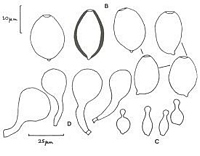|
 Conocybe sp. 4 Conocybe sp. 4
BiostatusPresent in region - Origin uncertain
Images (click to enlarge)
Caption: B-D Segedin 165, B. Basidiospores; C. Cheilocystidia; D. Pileipellis units. |
Article: Watling, R.; Taylor, G.M. (1987). Observations on the Bolbitiaceae: 27. Preliminary account of the Bolbitiaceae of New Zealand. Bibliotheca Mycologica 117: 61 p. + 17 pl.
Description: Pileus 24 mm, fawn brown, not shiny, convex-campanulate. Stipe 62 x 2 mm cartilaginous, twisted, equal except for slightly bulbous base. Gills free-adnexed, cinnamon. Smell strongly nitrous.
Basidiospores 13.5-16 x 9.5-12 x 8.5-9 µm, broadly elliptic to ovate in face-view, distinctly flattened in side-view, thick-walled; germ-pore broad, central. Basidia 4-spored. Cheilocystidia lecythiform, 16-19 x 9-10.5 µm, capitulum 3-4µm broad. Pileipellis a palisadoderm with spheropedunculate cells 42-44 µm broad, infrequently intermixed with lecythiform cells. Clamp-connections present; oleiferous hyphae present in pileus.
Notes: Unfortunately no caulocystidia were located; it was therefore impossible to assign the collection to a particular section, although it undoubtedly belongs to sg. Conocybe. The large size of the basidiospores and the poor differentiation of the neck of the cheilocystidia suggest a member of the C. pubescens (Gillet) Kuhner group; the nitrous smell is unusual.
|